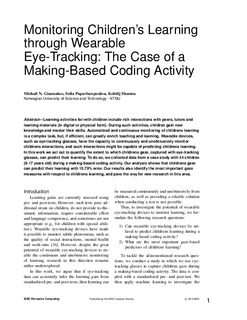| dc.contributor.author | Giannakos, Michail | |
| dc.contributor.author | Papavlasopoulou, Sofia | |
| dc.contributor.author | Sharma, Kshitij | |
| dc.date.accessioned | 2020-02-21T11:22:32Z | |
| dc.date.available | 2020-02-21T11:22:32Z | |
| dc.date.created | 2020-01-17T23:42:24Z | |
| dc.date.issued | 2020 | |
| dc.identifier.issn | 1536-1268 | |
| dc.identifier.uri | http://hdl.handle.net/11250/2643211 | |
| dc.description.abstract | Learning activities for/with children include rich interactions with peers, tutors, and learning materials (in digital or physical form). During such activities, children gain new knowledge and master their skills. Automatized and continuous monitoring of children’s learning is a complex task, but, if efficient, can greatly enrich teaching and learning. Wearable devices, such as eye-tracking glasses, have the capacity to continuously and unobtrusively monitor children’s interactions, and such interactions might be capable of predicting children’s learning. In this article, we set out to quantify the extent to which children’s gaze, captured with eye-tracking glasses, can predict their learning. To do so, we collected data from a case study with 44 children (8–17 years old) during a making-based coding activity. Our analysis shows that children’s gaze can predict their learning with 15.79% error. Our results also identify the most important gaze measures with respect to children’s learning, and pave the way for new research in this area. | nb_NO |
| dc.language.iso | eng | nb_NO |
| dc.publisher | IEEE | nb_NO |
| dc.title | Monitoring Children’s Learning Through Wearable Eye-Tracking: The Case of a Making-Based Coding Activity | nb_NO |
| dc.type | Journal article | nb_NO |
| dc.type | Peer reviewed | nb_NO |
| dc.description.version | acceptedVersion | nb_NO |
| dc.source.journal | IEEE pervasive computing | nb_NO |
| dc.identifier.doi | 10.1109/MPRV.2019.2941929 | |
| dc.identifier.cristin | 1776304 | |
| dc.relation.project | Norges forskningsråd: 255129 | nb_NO |
| dc.relation.project | EC/H2020/787476 | nb_NO |
| dc.relation.project | Norges forskningsråd: 290994 | nb_NO |
| dc.description.localcode | © 2019 IEEE. Personal use of this material is permitted. Permission from IEEE must be obtained for all other uses, in any current or future media, including reprinting/republishing this material for advertising or promotional purposes, creating new collective works, for resale or redistribution to servers or lists, or reuse of any copyrighted component of this work in other works. | nb_NO |
| cristin.unitcode | 194,63,10,0 | |
| cristin.unitname | Institutt for datateknologi og informatikk | |
| cristin.ispublished | true | |
| cristin.fulltext | postprint | |
| cristin.qualitycode | 2 | |
